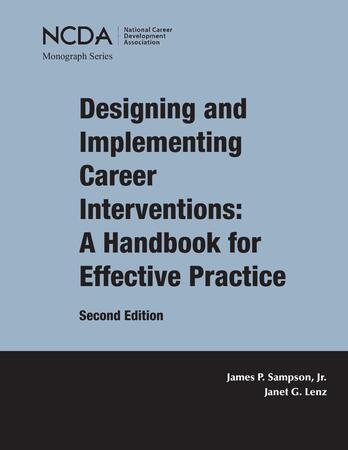by James P. Sampson, Jr., and Janet G. Lenz
 While the importance of developing and implementing career interventions is widely recognized, there is less clarity as to how to initiate this process. The second edition of Designing and Implementing Career Interventions: A Handbook for Effective Practice addresses this issue by offering a comprehensive approach to career intervention implementation. Dr. James P. Sampson, Jr., and Dr. Janet G. Lenz detail each step of the design and implementation process in a succinct but thorough manner.
While the importance of developing and implementing career interventions is widely recognized, there is less clarity as to how to initiate this process. The second edition of Designing and Implementing Career Interventions: A Handbook for Effective Practice addresses this issue by offering a comprehensive approach to career intervention implementation. Dr. James P. Sampson, Jr., and Dr. Janet G. Lenz detail each step of the design and implementation process in a succinct but thorough manner.
The centerpiece of the handbook is its “Eight-Step Model for Implementing Improved Career Interventions.” This model takes into account every aspect of the intervention process, from evaluation to training to implementation. The model’s depth helps both experienced and inexperienced career service providers to address aspects of the intervention process that are often overlooked. The model is dynamic in that it can be tailored to best address the needs and makeup of a specific organization. The authors emphasize that the model is not intended to be a one-size-fits-all approach and that “no two organizations are likely to create the same implementation plan.” For this reason, staff members incorporating this model can be sure that they are covering the necessary bases in their intervention plan while not abandoning their organization’s unique style.
The authors encourage the reader to adopt as much or as little of the model as they need, depending on factors such as organization size, typical client concerns, and available technology. In a similar vein, the handbook is useful for staff members in a variety of roles, both in person and virtual, and the authors provide recommendations regarding which sections of the handbook are most relevant based on the specific position that the staff member occupies within their organization. The text’s appendices include tools, such as a Career Intervention Plan and Implementation Checklist, that can help staff members to translate the teachings of this handbook into daily practice. Supplemental resource suggestions, such as career assessments, information guides, and career service professional standards, are also provided throughout the text.
Along with presenting the eight-step model, the authors provide additional guidance on how to effectively implement an intervention plan. They highlight the significance of career theory, research, professional standards, and policy in the intervention process, and they discuss how the interconnection of these aspects contributes to improved career interventions. The handbook also stresses the importance of collecting evaluation and accountability data. The authors discuss various evaluation techniques and the specific situations in which to utilize each type of evaluation. In addition, a five-step model of accountability provides an outline for staff members seeking to monitor the impact of their interventions. This discussion of evaluation and accountability is helpful for career service organizations striving to implement evidence-based practices, as the enactment of these practices often leads to additional funding opportunities.
The section on cognitive information processing (CIP) and Holland’s RIASEC theory provides an outline of how career interventions can be tailored based on the theoretical orientation of a particular organization. Career staff members not trained in CIP or RIASEC theory may not be familiar with the specific CIP or RIASEC terminology mentioned in this chapter, but they can still come away with an understanding of how career theory, in general, can be integrated with practice. This chapter also highlights the various modalities—such as assessment, psychoeducation, and modeling—that staff members should consider when designing and implementing interventions. This discussion of the myriad techniques available in the intervention process reminds the reader that career interventions can take many different forms in a range of settings.
Another strength of the handbook is its recognition that intervention design and implementation is not done in a vacuum. Throughout the text, the authors encourage the reader to consider how leadership and collaboration affect the efficacy of career interventions. They provide examples of effective and ineffective techniques related to leadership and staff beliefs, as well as the outcomes that are likely to result from the application of those techniques. The inclusion of these interpersonal considerations can help career service leaders to embrace and navigate the inevitable change that occurs in organizations.
Overall, this handbook is a valuable tool for career service practitioners in a variety of settings and roles, and its methods can easily be adapted to align with the values and needs of specific organizations.
Sampson, J. P., Jr., & Lenz, J. (2023). Designing and implementing career interventions: A handbook for effective practice (2nd ed.). National Career Development Association.
Reviewed by: Danny Chiarodit, MS
